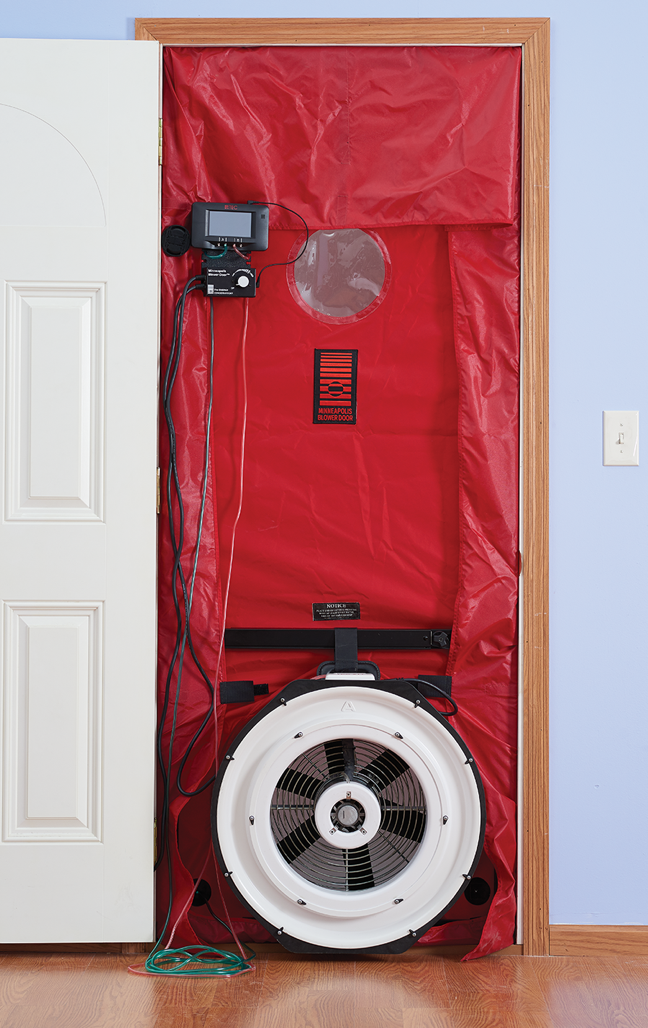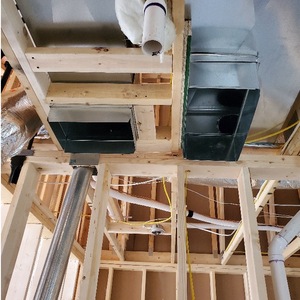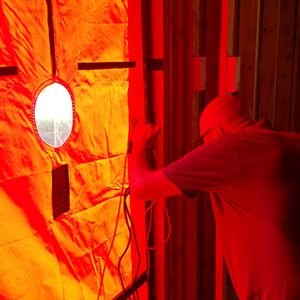Image Credit: Images #1, #2, and #3: The Energy Conservatory
Image Credit: Images #1, #2, and #3: The Energy Conservatory This is the DG1000 starter screen. Here the DG1000 is reading out all the key data for a standard blower door depressurization test. Note how clear and easy it is to read. Here I am demonstrating the new TEC blower door kit for a group of folks who are new to the airtightness testing requirements mandated by the 2105 International Energy Conservation Code.
Image Credit: Image #4: Peter Yost
I don’t do blower door work every day, but I do enough of it to appreciate the attention to detail that The Energy Conservatory (TEC) built into its new blower door kit. The kit features a digital pressure and air flow gauge, the DG1000.
I have used both TEC and Retrotec blower door kits and found them trustworthy and rugged. And I once asked TEC principal Gary Nelson if there were any reasons we should include just one of the two blower door equipment options in our BuildingGreen-approved products directory.
“Hmm…you are giving me a golden marketing opportunity,” started Gary, “but to be honest, both companies make good equipment; you should list them both.”
But recently I got to work with a brand spanking new TEC blower door kit that included the DG1000, and here are the features that sold me:
(1) All the equipment fits together physically. What I mean by this is:
- The blower door frame no longer has a clunky “gun” case; it has a soft but rugged fabric case with a slot for each frame member. The new case ismuch easier to deal with in terms of transporting and storing.
- There is a single sturdy mounting plate for both the digital gauge and the rheostat or fan speed controller, with a screw jack that makes it really easy to secure to a door frame or other trim, at any height.
- The DG1000 has four corner backside magnets that correspond to the same configuration on the metal of the mounting plate, so it’s easy to mount and release the gauge, even while it is held firmly in place.
- The fan speed controller has a built-in cooling fan so it never overheats, no matter how long you may run the blower door, at any speed.
- The DG1000 is essentially now a gauge and computer, but it is still rugged and comes with a very robust case — so no worries for the rough-and-ready aspect of work on job sites.
(2) The DG1000 is sophisticated and intuitive.
(3) The TEC help system is really unparalleled; the company offers:
- A whole library of pdf guides
- A whole library of how-to TEC website and YouTube videos.
- Quick-response human tech support.
But enough of what I think about the new TEC blower door kit; I decided to check in with one of the most seasoned building performance specialists in our industry, Andy Wahl of AC Home Performance of Bay Point, California. Andy has conducted thousands of building audits; his first blower door in 1990 had a wooden frame! Andy was also involved in TEC development of the DG1000.
“I really like the new screen; it’s much easier to see and read,” begins Andy Wahl. “I also like the rechargeable user replaceable batteries. But there are two functional aspects of the new system that are important to my work:
- Long averaging of building depressurization when investigating combustion appliance performance; other systems have a 2-minute limit on averaging.
- Being able to see the blower door numbers on my phone while reading the digital pressure gauge in my hand (when doing series leakage work).”
Andy also thought that the ability to update the DG1000 is a huge advantage. “There are all kinds of capabilities that we talked about as the DG1000 was being developed that we might not necessarily see yet, but these will be easily added over time,” says Andy. One example dear to Andy’s heart is setting up the DG1000 with a checklist system so that any user can be literally walked through the steps it takes to do any manner of blower door work.
“We have to be careful, though; we don’t want a tool like the DG1000 to get so easy that we don’t need trainers like me anymore,” joked Andy.
The equipment is always improving
Let’s see what TEC can do next: maybe a powerful calibrated fan that does not weigh 33 pounds…
The new DG1000-based blower door kit retails for $3,295.
P.S. – I got to road test the new TEC blower door kit because TEC is a sponsor of a new series of workshops that Steve Baczek and I are doing called Homebuilding Crossroads: 2015 Energy Code & High Performance. At each of the first three events, a group of about 30 of the 100+ attendees stayed for a blower door demonstration and discussion.
That is no coincidence or anomaly: the fact that the 2015 International Energy Conservation Code requires blower door airtightness testing of 3 ach50 or less is bringing a whole new group of building professionals into the building science and high performance arena. Steve and I (and the workshop sponsors) believe that our industry is turning an important corner – the one where understanding and practicing building science-driven high performance is no longer optional. It’s a good time to be putting a blower door kit into your toolbox, if you have not already.
In addition to acting as GBA’s technical director, Peter Yost is the Vice President for Technical Services at BuildingGreen in Brattleboro, Vermont. He has been building, researching, teaching, writing, and consulting on high-performance homes for more than twenty years. An experienced trainer and consultant, he’s been recognized as NAHB Educator of the Year. Do you have a building science puzzle? Contact Pete here. You can also sign up for BuildingGreen’s email newsletter to get a free report on avoiding toxic insulation, as well as regular posts from Peter.
Weekly Newsletter
Get building science and energy efficiency advice, plus special offers, in your inbox.
















0 Comments
Log in or create an account to post a comment.
Sign up Log in